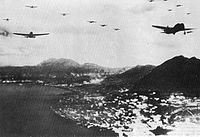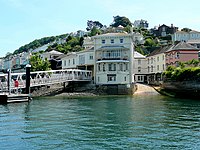HMS Cicala
 An aerial photograph of an Insect-class vessel taken in August 1918
| |
| History | |
|---|---|
| Name | HMS Cicala |
| Namesake | Cicada (archaic spelling) |
| Builder | Barclay Curle |
| Launched | 1915 |
| Fate | Scuttled 21 December 1941 in the West Lamma Channel during the Battle of Hong Kong |
| General characteristics | |
| Class and type | Insect-class gunboat |
| Displacement | 625 long tons (635 t) |
| Length | 237 ft 6 in (72.39 m) |
| Beam | 36 ft (11 m) |
| Draught | 4 ft (1.2 m) |
| Propulsion | 2 Yarrow-type engines and boilers 2000 IHP |
| Speed | 14 knots (16 mph; 26 km/h) |
| Complement | 55 |
| Armament |
|
| Armour |
|
HMS Cicala was a
Construction
The
The Cicala measured 237 feet 6 inches (72.39 m) in length, 36 feet (11 m) in beam and just 4 feet (1.2 m) in draught; her displacement was 625 long tons (635 t). The vessel was equipped with two Yarrow-type engines and boilers providing 2,000 steam horsepower and allowing her to reach 14 knots (16 mph; 26 km/h).[5] With her flat bottom and three rudders she was described as being very manoeuvrable (she could turn "almost on a sixpence").[7]
The Cicala was equipped with two
Service
Cicala was deployed against the Russian Bolsheviks during the British campaign in the Baltic (1918–1919). In June 1919 her crew mutinied, refusing orders to sail up the River Dvina to engage Bolshevik artillery batteries. Other British vessels had run aground in shallow waters and come under attack from the batteries, gun barges, floating mines and aircraft. Rear Admiral John Green ordered the other ships in his squadron to turn their guns on the Cicala and threatened to open fire, after which the mutineers backed down and obeyed the orders.[8] Green's senior officer, Rear Admiral Walter Cowan, was uncertain if the crew could be tried for mutiny as it was a wartime-only offence and Britain had not formally declared war against the Bolsheviks. The Admiralty in London confirmed that charges could be brought and Cowan's court-martial sentenced five ringleaders to death, afterwards commuted to five years imprisonment.[9]
Cicala was later assigned to the China station. In November 1923 she assisted a Japanese merchant steamer that had grounded while escaping pirates near Guangzhou.[10] On 4 June 1935 the Cicala surprised five pirate sampans which had just attacked a junk carrying firewood and ammunition on the West (Xi) River and drove the pirates away.[11][12] In 1937 she responded to a report of a pirate attack on a steamer; the crew of the steamer had repulsed an attack but suspected some pirates got aboard. Cicala put aboard a naval guard party and escorted the vessel to Shiuhing (Zhaoqing) where at least 10 suspects were arrested.[13]
Battle of Hong Kong
Cicala was at Hong Kong when it was invaded by Japanese forces on 8 December 1941, beginning the Battle of Hong Kong. Her commander was Lieutenant Commander John Boldero, a veteran of the Battle of Jutland; Boldero was commander of the motor torpedo boat flotilla in the harbour until April 1941 when he lost an arm in a collision with another vessel.[7] He discharged himself from hospital and was in command of Cicala by the time of the battle.[7]
Cicala spent the first two weeks of the battle travelling around the harbour to provide fire support against Japanese attacks. Boldero steered her with his left arm and she survived at least 60 Japanese dive bomber attacks.[7]
By 21 December it had become clear that the British were losing the battle and many British vessels were ordered to be scuttled. Cicala and the motor torpedo boats were permitted to try to escape to Singapore and Boldero loaded her with fuel for the attempt.[7] At 10.00 that morning he sailed to Deep Water Bay to provide fire support to Pillbox 14, which was under attack by Japanese infantry. The Cicala came under heavy mortar fire and was attacked by six Japanese dive bombing aircraft. The Cicala was hit by bombs; her boats were holed, steampipes broken and hull shattered. Almost all of her crew survived and were taken off by the motor torpedo boat MTB 10.[14] The Cicala was scuttled in West Lamma Channel by depth charges launched from MTB 09.[14][15]
Cicala's name was reused later in the Second World War for the stone frigate established at the Royal Dart Hotel at Kingswear, Devon. This station commanded all coastal forces in and around Dartmouth.[16]
-
Japanese aircraft over Hong Kong, 1941
-
The Royal Dart Hotel
References
- ^ ISBN 978-1-84832-189-2.
- ^ ISBN 978-962-209-615-8.
- ^ Brassey, Earl Thomas Allnutt (1942). Brassey's Annual: The Armed Forces Year-book. Praeger Publishers. p. 254.
- ISBN 978-1-5267-9328-7.
- ^ ISBN 978-1-84908-409-3.
- ISBN 978-0-521-63241-6.
- ^ ISBN 978-988-8083-76-3.
- ISBN 978-1-84725-021-6.
- ISBN 978-0-19-289334-5.
- ISBN 978-1-350-17618-8.
- ^ Association, Commonwealth Parliamentary (1935). Report on Foreign Affairs. p. 300.
- ^ Naval Institute Proceedings. United States Naval Institute. July 1935. p. 1182.
- ^ Oriental Affairs: A Monthly Review. 1937. p. 110.
- ^ ISBN 978-988-8083-76-3.
- ISBN 978-1-84753-966-3.
- ISBN 978-0-7509-5926-1.


